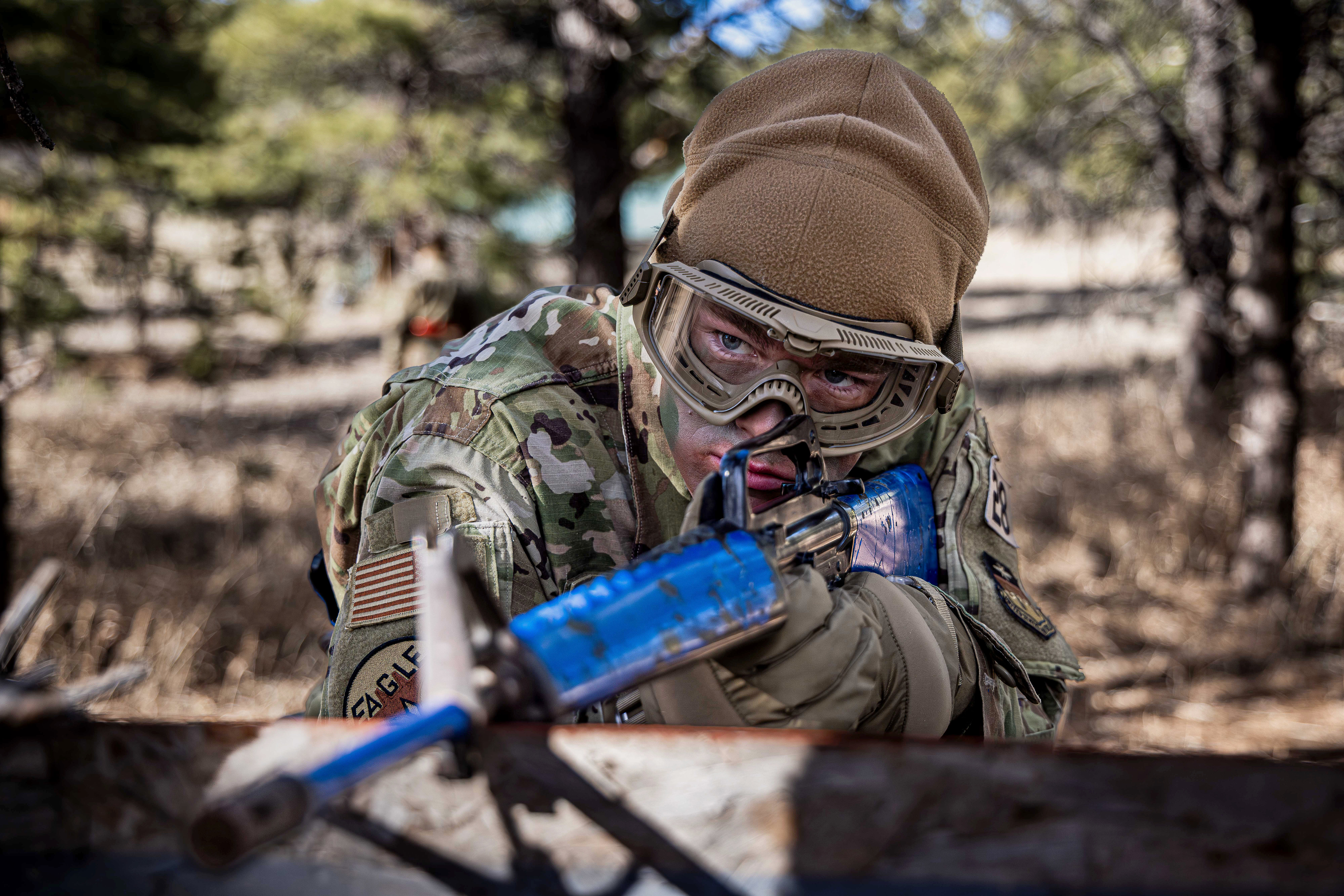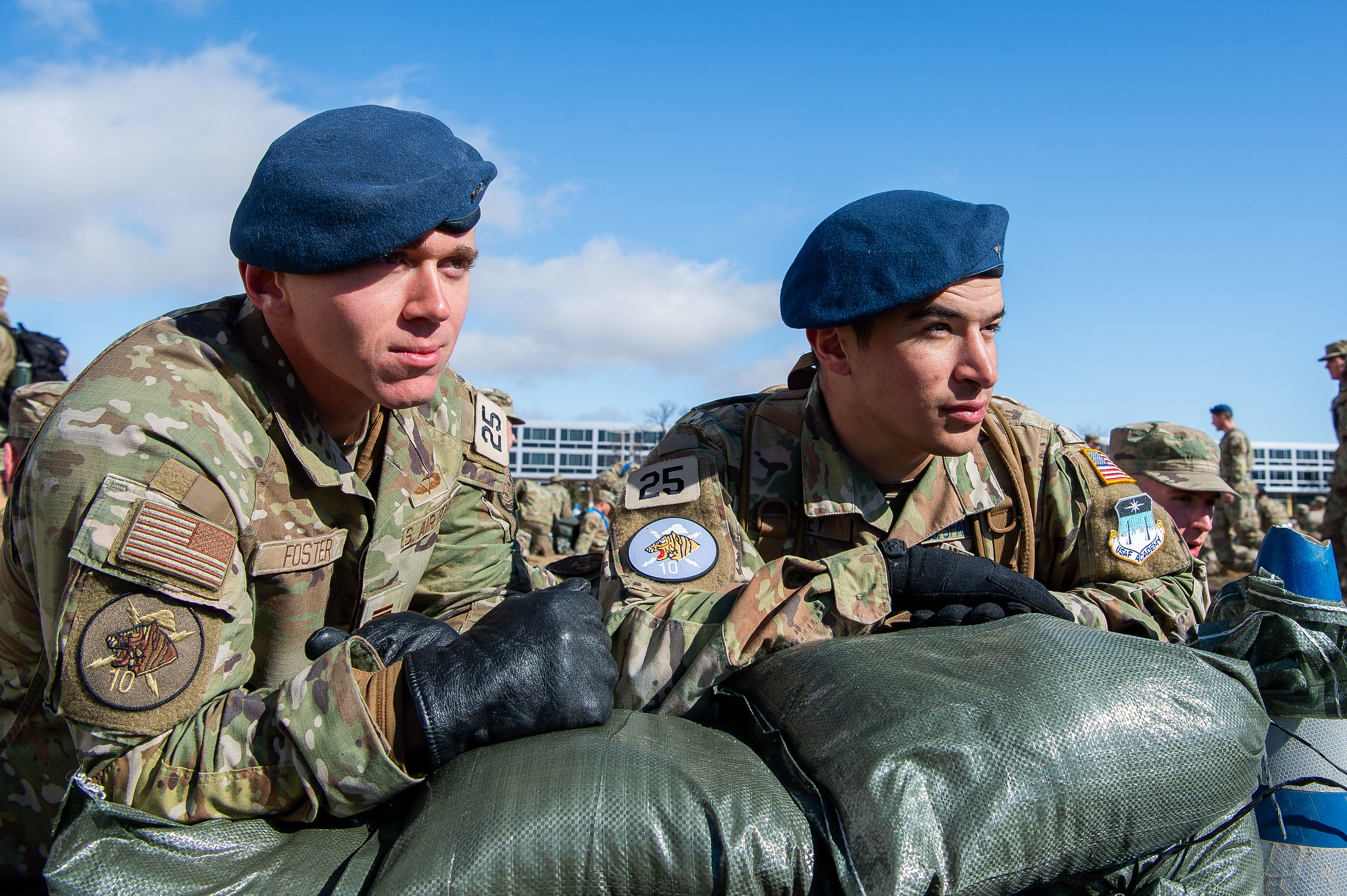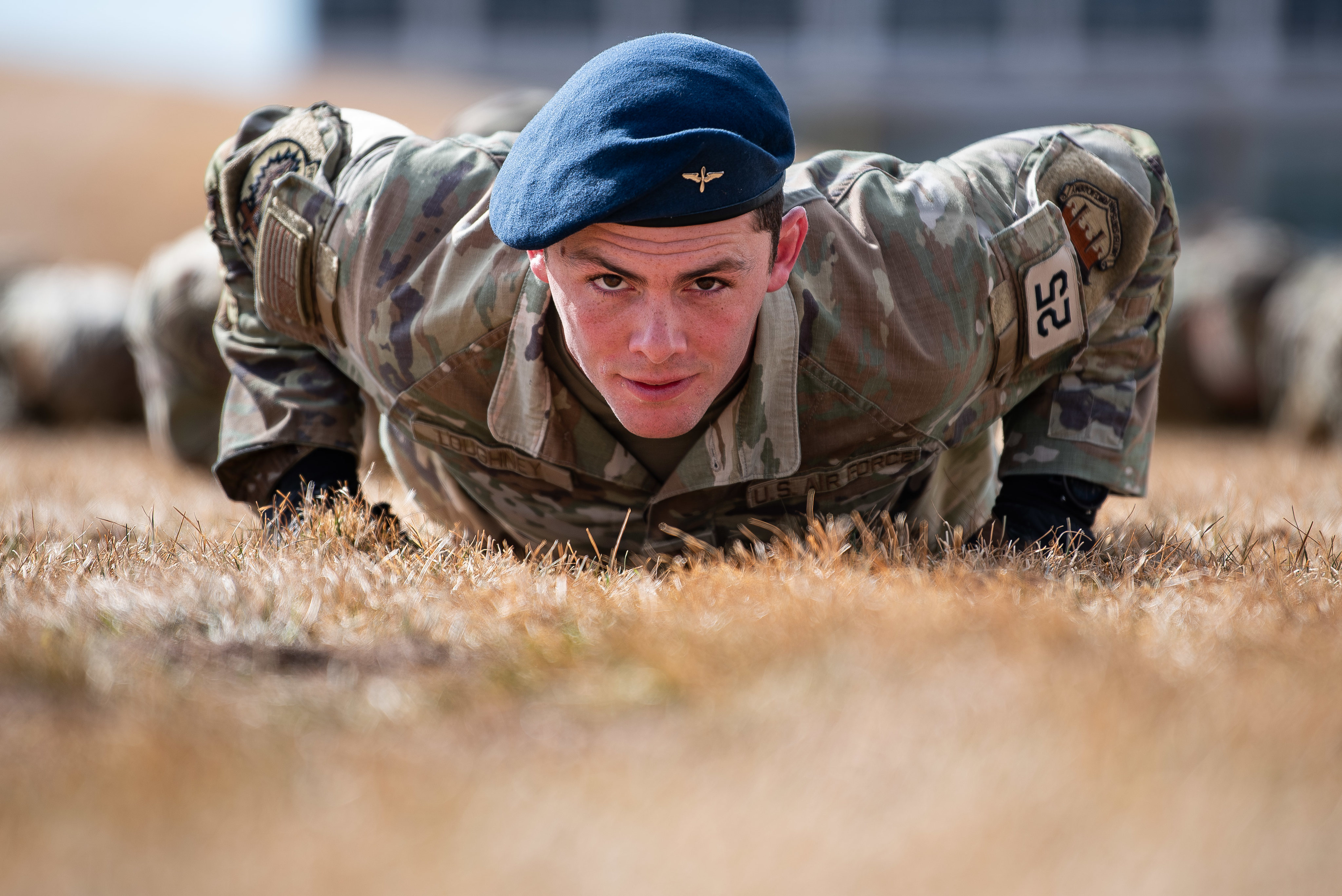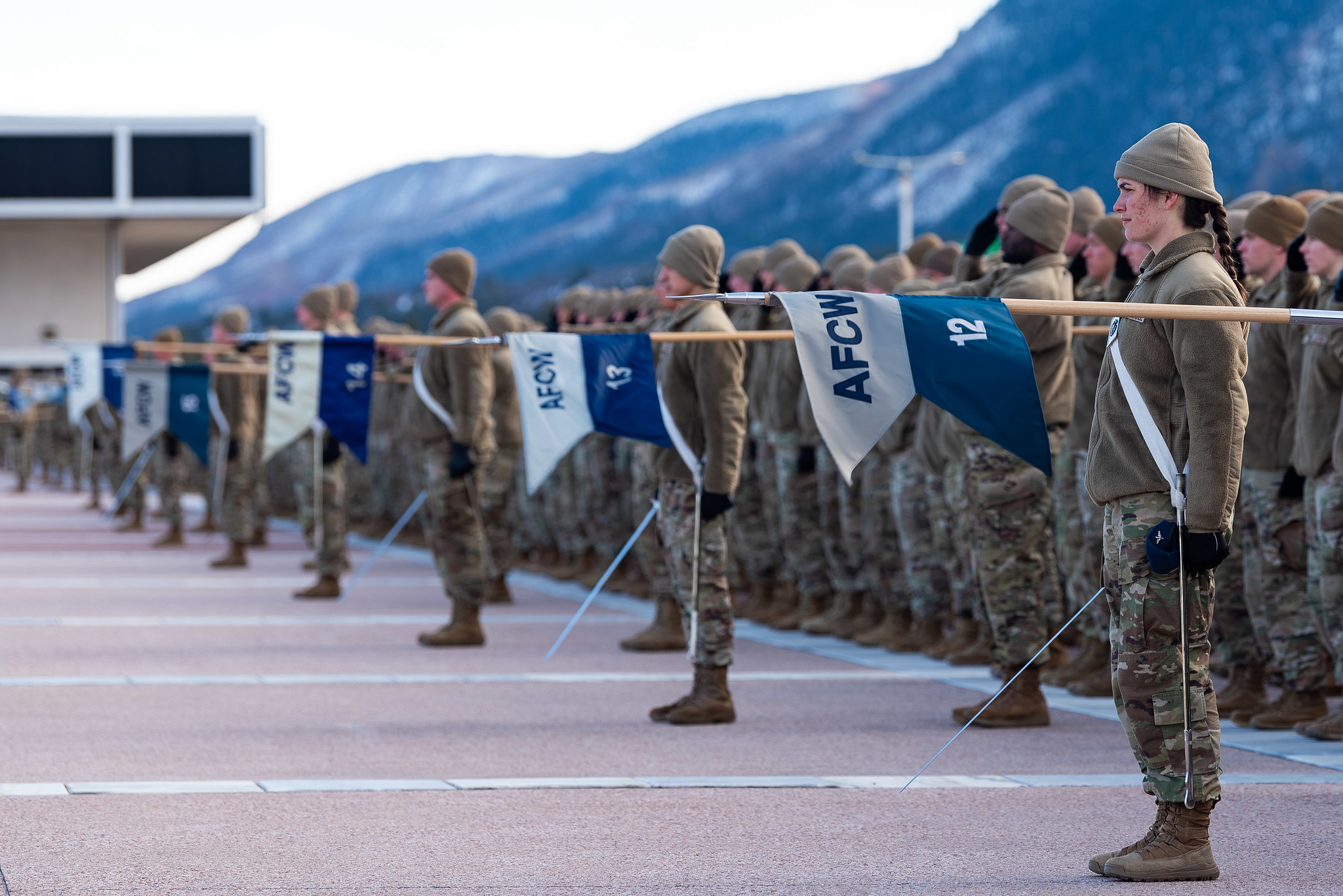Checkpoints: Forged in fire
Largest-ever Culminating Exercise puts Ready Airman Training skills to the test
Over a span of four late-winter days, the U.S. Air Force Academy transformed from a world-class military and educational institution into an Indo-Pacific island rife with escalating geopolitical tensions.
From March 5 to March 8, forward operating stations sprung up on otherwise calm, well-manicured athletic fields; cadets armed with dummy rifles constructed defensive fighting positions on the commandant’s lawn; soon-to-be second lieutenants evaded “enemy combatants” along the foothills west of the Academy; shouts of “who comes here?” could be heard as sentries reacted to potential threats.
Against the backdrop of frigid temperatures, the Academy’s 40 cadet squadrons took on the demanding 2025 spring Culminating Exercise, or CULEX, designed to test and enhance warfighter readiness and leadership skills, and to evaluate cadet proficiency in newly developed Ready Airman Training skills (see sidebar on p.23).
The Academy launched this new training model in fall 2024, when all 40 cadet squadrons completed a two-day exercise that replaced the Commandant’s Challenge and Training Day. That exercise paved the way for the expanded 2025 CULEX.
The most recent exercise marked a major evolution in the Academy’s approach to cadet training, serving as a proof of concept for future exercises. The event tested cadets on RAT skills and prepared them for agile combat employment in modern operational environments.
“The CULEX provides an opportunity for cadets to showcase and implement the Ready Airman Training they received throughout the year preparing them for success across the operational force,” Superintendent Lt. Gen. Tony Bauernfeind ’91 says. “Ready Airman Training was designed to prepare airmen and guardians for deployment, and this training fits well with CULEX goals to enhance warfighter readiness and develop a more lethal and ready force through simulating complex, real-world military engagements. By focusing on foundational warfighter skills of shoot, move, communicate, medicate and automate, we are preparing our warfighters with the skills our joint force requires. Our latest example includes the Class of 2025 completing qualification and requalification on the M-18, creating warrior leaders who are more proficient and confident in their weapons and engagement techniques.”
Over the past academic year, the Academy revised the RAT curriculum to provide cadets with hands-on tactical and strategic experience. The multiday CULEX challenged cadets to lead, adapt and execute missions in physically and mentally demanding scenarios, including day and night operations across a variety of complex rotations.
“The scenarios developed for the CULEX test cadets’ warfighting skills, leadership abilities, team building and critical thinking (to include ethical challenges), preparing our cadets with the vital skills to operate on dynamic battlefields,” Gen. Bauernfeind says.

Strike, Protect, Lead and Adapt
According to Col. Maureen Trujillo, Cadet Group 3 commander, CULEX comprised one field training exercise and three “focused lane” training events: Strike, Protect and Lead and Adapt.
“Strike tested the cadets on their ability to conduct an evasion exercise and demonstrate small-unit tactics,” Col. Trujillo says. “The cadets were evading through the hills behind USAFA, and they had to demonstrate awareness and their basic communication skills.”
She adds that cadets demonstrated tactical casualty combat care skills and readiness, as well as attention to detail by bringing everything on their packing lists.
The Protect lane, Col. Trujillo adds, entailed cadets defending their areas of responsibility, to include positions on Stillman Field. Cadets were graded on integrated defense.
“Did they challenge people appropriately?” she says. “If you are coming up to the [entry control point], did they ask you [to] stop? … Were [cadets] able to demonstrate countersign capabilities?”
For Lead and Adapt, cadets applied cross-cultural competencies and communications and simulated key leader engagements. Participants faced several scenarios to test critical thinking skills, Col. Trujillo says.
“For example, one of the stations on the athletic fields provided a scenario to cadets where they were in a situation where the local civilians were throwing rocks at them,” she says. “So, then we asked the cadets, what is your action? Would you throw rocks back? Is that the proper thing to do as Americans? Or do you calm the situation and then take that information back to your leadership?”
Col. Trujillo says the rock scenario happened to her while deployed in Afghanistan.
In addition to the lanes, cadet groups participated in field training exercises at Jacks Valley.
“The bonus of all that was a superintendent’s challenge that took place after the cadets came back from the field,” Col. Trujillo says, adding that the timed challenge involved filling sandbags and carrying them across the commandant’s lawn to build a defensive fighting position and then undergoing a test to match ranks across all U.S. military branches.
“The cadets came back from the field extremely tired,” she explains. “Then they had to complete a physical challenge, and then they’re given the ranks of the Coast Guard for example, and they have to lay it out properly, and it’s all time-based. I think it was a lot more fun than they anticipated. Initially, the cadets were skeptical and stated, ‘Oh, we have to do this when we come back from the field?’ But it definitely demonstrated the teamwork that they had, and there’s a lot of camaraderie as well.”

STAY IN YOUR LANE
Cadet 1st Class Caleb Song, Cadet Squadron 33 member and Cadet Wing A-3 division chief, helped lead the exercise’s planning and execution.
“We had a [field training exercise] that was around 21 hours long per group and then we had focused lane training that was, in total, 18 hours,” Song says. “My team focused on planning the lane training portion.”
When conceptualizing began several months ago, Song says his team worked closely with permanent party and cadets to determine CULEX goals.
“We were given broad intent from permanent party of, ‘This is what we want [the exercise] to kind of look like,’ and then it was up to my team and giving them the tools and empowering them,” Song says. “I have a really great team. They honestly did so much work to get this done and lay the foundation for what the CULEX will be in the future.”
The Academy conducted a much smaller Culminating Exercise in fall 2024. Song says the scale of the most recent CULEX dwarfed in scope his previous USAFA training.
“Seeing the power of when cadets and permanent party work together and what can be done — that was really cool,” he says. “But for me personally, it was just trusting my team. … So, really, my role was to step back and let them take charge, and they did a fantastic job.”
Cadet 1st Class Amelia Berles, Cadet Squadron 06, a legal studies major, helped lead organization of the Lead and Adapt lane. She says the CULEX has better prepared her to take charge beyond the Academy.
“It’s definitely helped with being able to think on my feet,” she says. “And I’ve never had a group- or wing-level job in the Cadet Wing before — I’ve only ever worked squadron-level jobs. So going from planning events for about 100 people to doing something for 4,000 was definitely a learning experience. And all the logistics that are involved in planning such a large event — I feel like that’ll be very useful to carry on into the Air Force.”
Cadet 2nd Class Marcus Berrette, Cadet Squadron 29, acted as a “jack of all trades” while helping to organize the exercise, including helping script the Lead and Adapt lane.
He created scenarios including one involving the capture of an enemy general responsible for the loss of American lives.
“They were interrogating him, but he wasn’t giving them the information they wanted,” Berrette says of the scenario. “And so, they’re getting a little frustrated and wanting to go against the laws of war.”
Cadet 2nd Class Jaiden Lanier, Cadet Squadron 09, helped steer training in the Protect lane.
“We primarily focused on active threat responses, integrated defense, basic communications and [tactical combat casualty care],” Lanier says. “So, [building] scenarios where we can test about 4,000 cadets’ Ready Airman Training skills, and do that over the course of the CULEX, whether that’s inside or outside.”
LEAD THE WAY
The CULEX’s conception aligns closely with the Academy’s renewed emphasis on military training.
“This Culminating Exercise tested cadets’ adaptability, leadership and mission execution skills critical to succeeding in modern multi-domain operations while reinforcing their preparedness to meet future challenges,” Gen. Bauernfeind says. “The Class of 2025 impressively led our first steps toward more demanding military training at the Academy. These exercises reinforce the warfighter mindset and ensure our cadets are prepared to lead in the Air Force and Space Force on Day 1.”
Col. Trujillo says, “Adapting to the military training is our No. 1 priority. I think it’s great, because the cadets need to be in an environment where they’re stressed but also realize, ‘I can do this.’”
During the CULEX, the Cadet Wing took on varying responsibilities, but the training blurred the lines between four-degrees and firsties.
“You had a role, and everybody saw your role as something that was valuable to the team,” Col. Trujillo says.
She illustrates this with a story about a Strike lane land navigation exercise. With compass and map in hand, a fourth-degree cadet led her team — including first-degree cadets — to its destination.
“It was really neat to see that her squadron, and that flight in particular, gave her the compass and the map and said, ‘All right, you take us where we need to go.’”
Col. Trujillo adds, “That was definitely an example of something that we’ve moved toward this year — going from a fourth-class system to the four-class system — ensuring that all classes of our cadets are not only seen as leaders, but also as followers, good teammates, and that they communicate with one another.”
So, in the end, what does a successful CULEX look like?
“Our cadets, faculty and staff put in a tremendous amount of effort into our spring CULEX, and it showed,” Gen. Bauernfeind says. “They executed exceptionally well. It was our first large-scale exercise, so we are still in the crawl-walk phase of our military training, but we learned valuable lessons about what worked well and where we can improve. The exercise provided a solid foundation for our four-class system and military training. However, we also identified a need for greater resources and subject matter experts to advance our cadets and prepare them for their roles and responsibilities in operational units.”
Col. Trujillo says getting fully to walk means adding more stress. The most recent CULEX ran on a tight schedule, so cadets knew what to expect and when to expect it.
Adding stressful scenarios to the field training march in Jacks Valley and keeping cadets in the dark regarding scheduling would add to the spontaneity and realism, she says.
She adds that recruiting operational experts to teach specialized RAT skills would also improve future exercises. Explosive ordnance experts or those trained in building and protecting defensive fighting positions could further exercise practicality.
THE EVOLUTION BEGINS
The Class of 2025 contributed to and laid the groundwork for future Culminating Exercises, and subsequent classes “should see the evolution,” Col. Trujillo says.
“I will say, though, the firsties who experienced the spring CULEX — they were very pleased,” she says, adding, they enjoyed the camaraderie and teamwork.
The CULEX, she adds, has better prepared cadets upon commissioning.
“It puts them in a mindset that — especially our firsties — ‘I am X amount of days from becoming a second lieutenant and probably months away, if something happens, from being on the front line.’” And so, she says, “I think it’s a great test for them mentally, and it also puts them in a great mental state to say, ‘I’m ready.’”
Col. Trujillo says, “The experience was real. We had [adverse] weather, which is going to happen when you’re in the field. And so, getting up early, making sure that our bodies were ready to go and hydrated doing the five-mile march out there in the cold. It started snowing in the afternoon, so we were all getting wet. But it’s part of the environment when you’re deployed, or in a situation where you’re out in the field.”
Each CULEX going forward will undergo refinements, but this academic year’s exercises have laid the groundwork to further strengthen future airmen and guardians.
“We expect to build on this year’s CULEX to develop more challenging and in-depth scenarios while procuring the warfighting equipment necessary for realistic training,” Gen. Bauernfeind says. “Additionally, we are implementing a Cadet Basic Instructor Course, where cadets will revive the warrior ethos and become certified military training instructors within their squadrons. … By reaching instructor-level proficiency, they will have the skills to instruct the lower classes, further supporting the four-class system and preparing our cadets for the complex operational challenges they will face after commissioning.”
Col. Trujillo agrees, saying, “It’s a great opportunity for our cadets to show their skills, to show teamwork and followership. And there’s nothing that beats being out in the field.”


